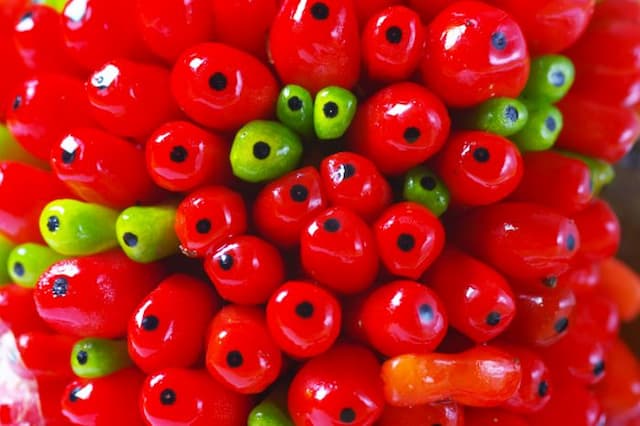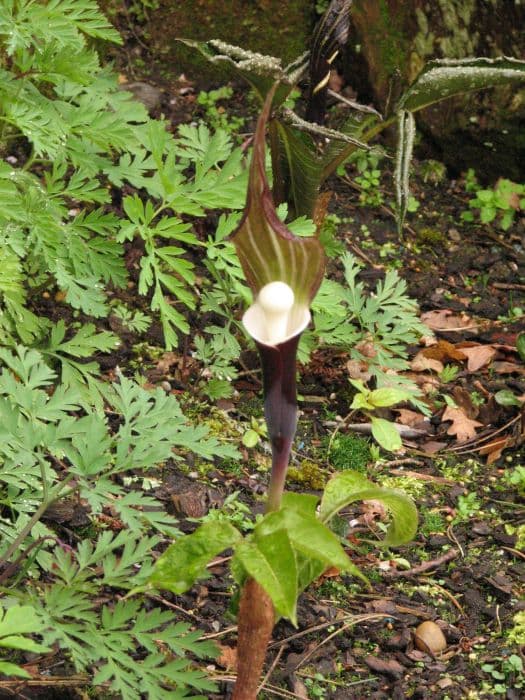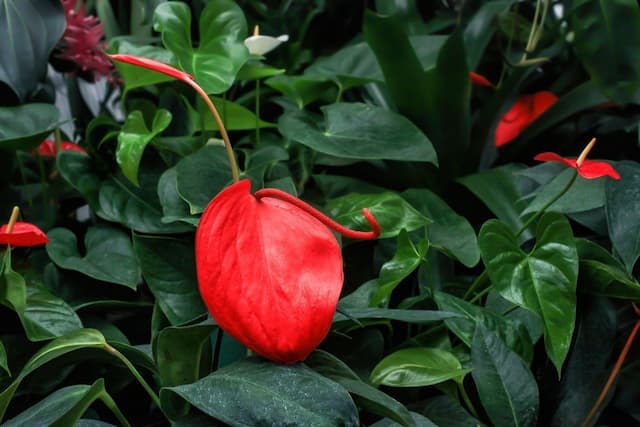Calla Lily 'Captain Safari' Zantedeschia 'Captain Safari' (PBR) (Captain Series)

ABOUT
The Zantedeschia 'Captain Safari', commonly known as a Calla Lily, belongs to the Captain Series, renowned for its striking and elegant flowers. The plant showcases a distinctive floral structure with a showy spadix, which is a finger-like spike, surrounded by a large, trumpet-shaped spathe. The spathe is the unique part often mistaken for a petal due to its vibrant color and ornate form. In the Captain Safari variety, the spathe unfurls in a captivating blend of colors, often featuring warm, creamy hues with brush strokes of deep oranges and yellows, exuding a sense of exotic warmth. The foliage of this Calla Lily complements its florid display with lush, green leaves. The leaves are arrow-shaped with smooth edges and a glossy texture, further adding to the plant's visual allure. The contrast between the foliage and the bright bloom creates a compelling composition. The Captain Safari is often celebrated for its dramatic and bold flowers, which make it a popular choice for ornamental purposes and as a cut flower. Its appearance is emblematic of the elegance and grace that Calla Lilies are renowned for.
About this plant
 Names
NamesFamily
Araceae
Synonyms
Calla Lily, Arum Lily, Captain Safari Calla Lily
Common names
Zantedeschia 'Captain Safari'.
 Toxicity
ToxicityTo humans
Calla Lily (Zantedeschia 'Captain Safari' (PBR) (Captain Series)) contains calcium oxalate crystals, which are toxic to humans. If any part of the plant is ingested, it can cause symptoms such as a burning sensation in the mouth and throat, swelling of the lips, tongue, and throat, difficulty swallowing, and potentially vomiting and diarrhea. In severe cases, breathing difficulties may occur due to swelling of the throat. Contact with the sap may also cause skin irritation.
To pets
Calla Lily (Zantedeschia 'Captain Safari' (PBR) (Captain Series)) is toxic to pets due to the presence of calcium oxalate crystals. If ingested, pets may experience symptoms including oral irritation, pawing at the mouth, excessive drooling, vomiting, and difficulty swallowing. In severe cases, ingestion can lead to dehydration, anorexia, and other complications. Contact with the sap may cause skin irritation as well.
 Characteristics
CharacteristicsLife cycle
Perennials
Foliage type
Evergreen
Color of leaves
Green
Flower color
Yellow
Height
1-2 feet (30-60 cm)
Spread
1-2 feet (30-60 cm)
Plant type
Herb
Hardiness zones
9
Native area
South Africa
Benefits
 General Benefits
General Benefits- Easy to Grow: Zantedeschia 'Captain Safari' is known for being easy to grow and care for, which makes it suitable for gardeners of all skill levels.
- Ornamental Value: With its striking flowers and elegant foliage, it adds an exotic and decorative touch to gardens, patios, and indoor spaces.
- Long-Lasting Blooms: The plant produces blooms that can last several weeks, providing a prolonged period of visual interest.
- Container Suitable: It can thrive in pots and containers, making it ideal for spaces with limited ground soil.
- Attracts Pollinators: The blooms attract beneficial pollinators like bees and butterflies to the garden, supporting local ecosystems.
- Drought Tolerant: Once established, it has a level of drought tolerance, reducing the need for constant watering.
- Versatile Landscape Use: Can be used in mixed borders, as a focal point, or in mass plantings for a dramatic effect.
 Medical Properties
Medical PropertiesThis plant is not used for medical purposes.
 Air-purifying Qualities
Air-purifying QualitiesThis plant is not specifically known for air purifying qualities.
 Other Uses
Other Uses- Photography Prop: Calla lilies are often used by photographers to create beautiful, natural backdrops or to add elegance to product photography.
- Art Inspiration: The unique shape and vibrant color of the calla lily can serve as inspiration for artists in painting, sculpture, and other visual arts.
- Edible Flowers: Though not commonly known for this purpose, the flowers of The Zantedeschia can be crystallized and used as edibles to decorate desserts. Caution is advised as parts of the plant can be toxic if not prepared correctly.
- Dye Production: The pigments in calla lily petals can potentially be used to create natural dyes for textiles or art materials.
- Eco-Friendly Confetti: Dried calla lily petals can serve as biodegradable confetti for weddings or celebrations.
- Ink Making: The rich hues of calla lily petals could be used in the craft of homemade ink for writing or calligraphy.
- Teaching Tool: Calla lilies can be utilized in educational settings to teach botany and plant biology due to their distinct flower structure.
- Floral Water: Petals of the calla lily can be steeped in water to create a lightly scented floral water for use in cosmetics or room fresheners.
- Culinary Garnish: With proper culinary preparation, calla lilies can be used as an elegant garnish for high-end dishes.
- Mood Enhancer: The presence of calla lilies in a room is believed to enhance mood and create a calming atmosphere due to their beauty and form.
Interesting Facts
 Feng Shui
Feng ShuiThe Calla Lily is not used in Feng Shui practice.
 Zodiac Sign Compitability
Zodiac Sign CompitabilityThe Calla Lily is not used in astrology practice.
 Plant Symbolism
Plant Symbolism- Rebirth and resurrection: Historically, the calla lily, which the Zantedeschia 'Captain Safari' is categorized under, is often associated with the themes of rebirth due to its perennial nature, reemerging each spring with fresh growth after its winter dormancy.
- Beauty: The elegant form and vibrant color of the calla lily has made it a symbol of beauty in various cultures and contexts, including art and fashion.
- Purity and innocence: The pristine appearance of the calla lily flower has led to it being a symbol of purity and innocence, often used in religious ceremonies and weddings to represent these values.
- Transcendence: The calla lily's unique shape, with a flower that appears to hover or spiral upwards, can symbolize transcendence or rising above the mundane existence.
- Faith and fidelity: In the language of flowers, calla lilies are often associated with faith and fidelity, making them a popular choice for wedding bouquets and anniversary gifts.
- Overcoming challenges: The life cycle of the calla lily, with its ability to thrive even after harsh conditions, may symbolize the human ability to overcome challenges and emerge stronger.
 Water
WaterTo ensure the health of the Calla Lily, water it thoroughly when the top inch of soil feels dry, providing enough water until it runs out of the drainage holes in the pot—this might be once a week. During the active growth period in spring and summer, they may require more frequent watering, possibly every few days, depending on environmental conditions. Reduce watering in the fall and winter when the plant is dormant. Avoid overhead watering to prevent water from collecting in the crowns and leaves, which can lead to rot. Generally, approximately one gallon per week per plant is sufficient, but always adjust based on soil moisture and environmental conditions.
 Light
LightCalla Lilies thrive best in bright, indirect sunlight. A spot near a window that receives filtered light or a location with morning sun and afternoon shade would be ideal. Direct, harsh sunlight can scorch their leaves, so it's important to protect them from the intense midday sun.
 Temperature
TemperatureCalla Lilies prefer temperatures between 60 and 75 degrees Fahrenheit. They can survive minimum temperatures of around 50 degrees Fahrenheit but should be protected from frost and freezing conditions which can be detrimental. Ideal growth occurs within the specified temperature range without exposure to extreme heat or cold.
 Pruning
PruningPruning is essential for Calla Lilies to remove spent flowers and yellowing leaves, encouraging the plant to produce new growth. Prune the plant when the flowers fade by cutting the stem at the base. The best time for general pruning is after the blooming cycle is complete, which typically is in late summer or early fall.
 Cleaning
CleaningAs needed
 Soil
SoilCalla Lily 'Captain Safari' thrives in well-draining, rich soil with a slightly acidic to neutral pH of 6.0 to 7.0. A mix of peat, perlite, and compost suits it well.
 Repotting
RepottingCalla Lilies 'Captain Safari' should be repotted every 1-2 years or when they outgrow their current pot.
 Humidity & Misting
Humidity & MistingCalla Lily 'Captain Safari' prefers high humidity, around 60% or above, for optimal growth.
 Suitable locations
Suitable locationsIndoor
Place Calla Lily 'Captain Safari' in bright, indirect light indoors.
Outdoor
Grow Calla Lily 'Captain Safari' in partial shade outdoors.
Hardiness zone
8-10 USDA
 Life cycle
Life cycleZantedeschia 'Captain Safari', also known as Calla Lily from the Captain Series, starts its life as a rhizome (a type of bulb-like stem) which is planted in well-draining soil in early spring. As temperatures warm, it sprouts foliage and a strong stem that will eventually bear a distinctive, trumpet-shaped spathe flower, typically blooming in late spring to summer. After flowering, the plant focuses on storing energy in the rhizome as the leaves gradually yellow and die back, signaling the beginning of dormancy. During the dormant period in late fall to winter, the rhizome remains in the soil, conserving its energy for the next growing season. With the return of favorable conditions, new growth emerges from the rhizome, repeating the cycle. Proper care through each stage, such as adequate watering during growth periods and withholding water during dormancy, ensures the vibrancy and longevity of the plant's life cycle.
 Propogation
PropogationPropogation time
Spring-Early Summer
The Calla Lily, specifically the Zantedeschia 'Captain Safari' (PBR), is often propagated through dividing its rhizomes. The best time to propagate this plant is in the late winter or early spring, just before the growing season begins. To propagate by division, you remove the plant from its pot or from the ground, and gently tease apart the clumps of rhizomes, ensuring that each piece has at least one growth bud or "eye." You can then plant these rhizome pieces individually, placing them about 4 inches (about 10 cm) deep in a mix of potting soil and perlite or sand for drainage. Water the new plantings minimally until growth is evident, as overwatering can cause the rhizomes to rot.









